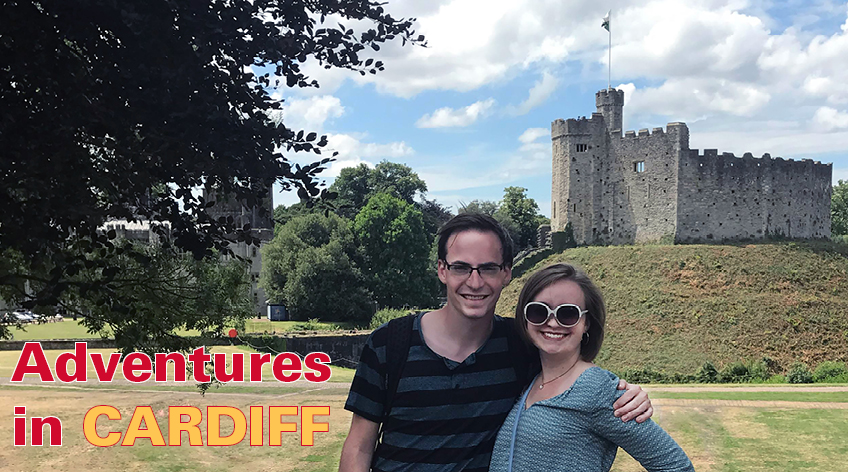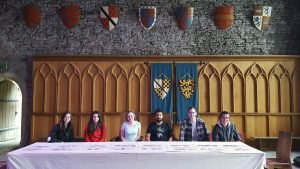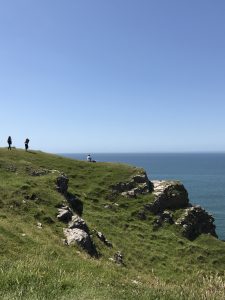
by Caitlyn McCreight and Kristin Clague
Studying overseas is an opportunity some college students are lucky to have — 1,636 Iowa State University (ISU) students studied abroad during the 2016-17 school year — but sometimes engineering students have schedules that don’t allow for extra traveling. This summer, however, four ISU engineering students applied and were selected to spend six weeks researching in Cardiff, Wales, putting the “study” in study abroad.
These students, Yana Aleksandrova, Jonathan Germick, Samuel Greene and Taylor Yeazel, along with two students from Virginia Commonwealth University, were chosen based on their academic performance and previous experience in research and coursework. They were interviewed and selected for International Research Experiences for Students (IRES): US/UK Multidisciplinary Collaboration in Magnetics, funded by the National Science Foundation (NSF). Distinguished Professor David Jiles, Affiliate Assistant Professor Ravi Hadimani and Associate Scientist Cajetan Ikenna Nlebedim lead the research group, with Jiles as principal investigator (PI) and Hadimani and Nlebedim as co-PIs. Hadimani is also an assistant professor and director of the Biomagnetics Laboratory with the Department of Mechanical and Nuclear Engineering at Virginia Commonwealth University (VCU). These students from both ISU and VCU worked with Cardiff University’s Magnetics and Materials Research Group at the Wolfson Centre for Magnetics.

According to the group’s website, magnetics technology has a major impact in areas such as renewable energy, electrical supply and energy efficiency. Research at the Wolfson Centre focuses on several areas related to the production, characterisation and application of magnetic materials.
“The research that I am doing at the Wolfson Center has introduced me to an area of magnetics research that is more mathematical and theoretical than the research I do at Iowa State,” said Greene, a senior in materials engineering at ISU. “I had approached magnetic materials from a materials point of view, but this internship has given me an opportunity to learn about the electrical engineering side of the field.”
Because the students are studying overseas, they have gained a perspective outside of what is found in Ames, Iowa.
“Learning so much about magnetics, along with getting to experience a different culture, has been the best part,” said Aleksandrova, a junior in computer engineering at ISU. “The culture is very different [in Cardiff]. People are more relaxed, they aren’t really in a rush, and the work ethic is completely different… It is a good mixture of work, but also plenty of time to explore.”
Henry Garcia, a junior in mechanical engineering at VCU, agreed.
“My biggest surprise was the stress-free living they embrace here,” he said. “Everyone seems to be happy and not overstressed with work. They spend a lot of time bonding with each other, and there are many social events with Ph.D.s and academics.”
During their free time, the students have traveled to Edinburgh, Scotland; London, England; Munich, Germany; Dublin, Ireland; Rome, Italy; Iceland; and Croatia; and some have plans to travel more after they complete their research, before coming back to the U.S.
“The most fun thing I have done this trip was traveling to Munich for my birthday,” Garcia said. “I met up with a friend from the States… He works for BMW as an engineer, and we got together with some of his BMW coworkers. Munich was an incredible city.”
The students have also enjoyed their “home” country of Wales.
 “The first weekend we were here, the final for the [Union of European Football Associations] Champions League tournament was being held in Cardiff, which gave us the chance to mingle with tens of thousands of people who came to the city for the match,” Greene said.
“The first weekend we were here, the final for the [Union of European Football Associations] Champions League tournament was being held in Cardiff, which gave us the chance to mingle with tens of thousands of people who came to the city for the match,” Greene said.
The group has traveled together, seeing more of Wales outside of Cardiff.
“The best memory I have from this trip is traveling to Worm’s Head in west Wales,” said Sierra Semel, a sophomore in mechanical engineering at VCU. “We went there as a group for the day and were able to walk to an island only accessible during low tide. It was one of the most beautiful places I have ever been, and it was a great bonding experience with the other students in the program.”
Because the students come from two different schools, a highlight of the trip was meeting each other and living and working together. All six students are sharing one six-bedroom “flat” in Cartwright Court, a residence hall at Cardiff University.
“I think the best thing has been the two-hour dinners the six of us have spent together,” said Yeazel, a senior in materials engineering at ISU. “We laughed and got to know each other. Within the first three days, we already felt like a family, and people had no idea we had all just met.”
This bonding has helped the group to achieve their personal research goals, giving them skills they can take back to the U.S. as they continue their education.
“I did not have too much familiarity with nanoparticles before I left, and now I know so much about them,” Yeazel said. “Most interesting to me is that these nanoparticles we made can be used to treat cancerous tumors by injecting them to the site and applying an external magnetic. This project is beneficial to my future, as nanoparticles are becoming increasingly more researched in the field of materials engineering.”
Germick, a senior in electrical engineering at ISU, has also gained research experience he may not have found on campus.
“I have always been interested in combining my interest in neuroscience and electrical engineering, and that is exactly what I am doing here,” he said.
The students majoring in mechanical engineering were able to learn and use the program COMSOL Multiphysics, an interactive software environment for modeling and simulating scientific and engineering problems.
“For my project, I am redesigning the magnetic domain viewer that the lab currently uses. To be able to test out my designs, I needed to learn how to do magnetic modelling. COMSOL is a very useful program for an engineer to learn, and this project gave me the opportunity to do so,” Semel said.
Garcia echoed her: “I have learned how to use COMSOL, which is a highly valuable asset, and a door has been opened into an entirely new world of electromagnetism and microwaves,” he said. “To be able to say I have worked in multidisciplinary projects that are not part of my major shows that I am versatile and can pretty much do anything.”
Overall, the students have done important research over these six weeks, and the overseas adventure will benefit them in the future.
“This research is good exposure to how I can use my major in the real world,” Aleksandrova said. “This definitely opened up several doors for me and exposed me to a lot of new things.”
Garcia agreed: “This ties into my career, since I can see myself working on various projects, ones that I may know nothing about, but I am willing to learn the material and make it work. Having international experience is so positive, and these experiences will take me places.”